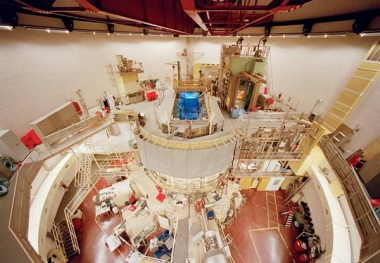Status updates from NRG and AECL explained the difficulties in conducting major repairs on the world's two biggest medical isotope production reactors.
The National Research Universal (NRU) unit at Canada's Chalk River Laboratory has been offline since mid-May 2009 due to corrosion-related water leaks from its main tank. Last month, the High-Flux Reactor (HFR) at Petten in the Netherlands went offline to fix an ingress of tiny air bubbles in a main coolant pipe.
 |
Blue Cerenkov Radiation illuminates the tank of the HFR, under which engineering is soon to take place (Image: NRG) |
It was initially hoped that NRU could be repaired in time to get back into operation before HFR went offline, but technical difficulties made that impossible.
Work on NRU is now past the half-way mark, with Atomic Energy of Canada Ltd (AECL) reporting 56% completion of the remote welding job, the main part of the repair. However, the last few welds are more complex and the company had to announce a revised date for return to service: the end of July.
This puts the restart back by another nine or ten weeks, although AECL said the new date includes a certain amount of contingency time. The company added that, "The remaining two repair sites present unique challenges that require first-of-a-kind technical solutions. To ensure that the repair process itself does not cause damage to the vessel an additional level of preparation is necessary to program the welding sequences and to qualify the welders."
At HFR, preparations for repairs are "progressing well and in line with the planned schedule", NRG announced.
The pipe to be repaired at HFR is beneath the reactor and encased in concrete, which also acts as a radiation shield. NRG said that so far, the reactor has been dismantled and its fuel has been stored. Next, a temporary radiation shield is to be remotely installed on the base of the reactor tank, which will eventually be emptied. A structure to support the tank then has to be put in place before concrete around the pipe can be removed. Drilling tests into the concrete have shown an acceptable level of radiation, confirming NRG's calculations.
Only a small number of research reactors across the world can supply molybdenum-99, which decays into technetium-99 en route to thousands of hospitals for use in imaging procedures. NRU has been the biggest producer, followed by HFR, but in their absence a reliable reduced supply has been maintained by close coordination between remaining main players: BR-2 at Mol in Belgium, Safari in South Africa and Osiris & Orphee at Saclay in France.
Researched and written
by World Nuclear News





_91467.jpg)
_47120.jpg)
_16439.jpg)





